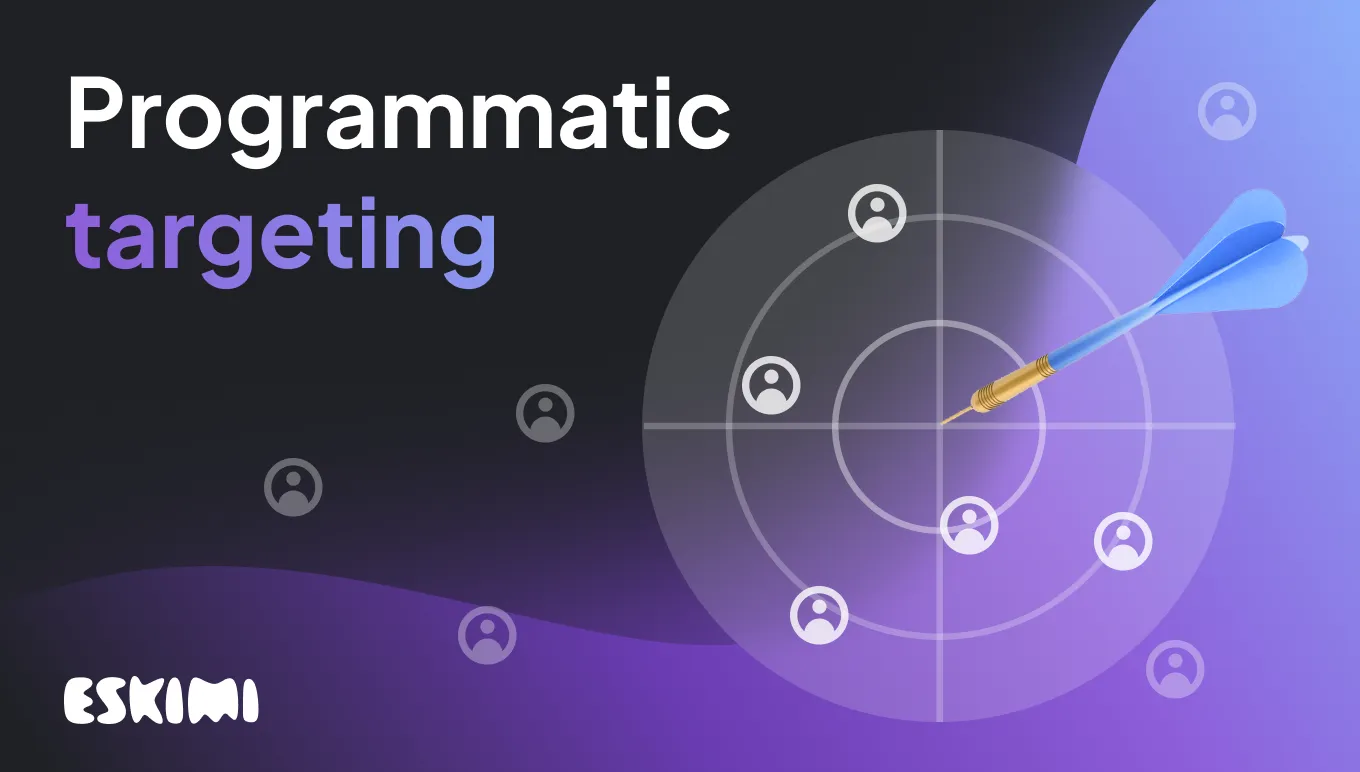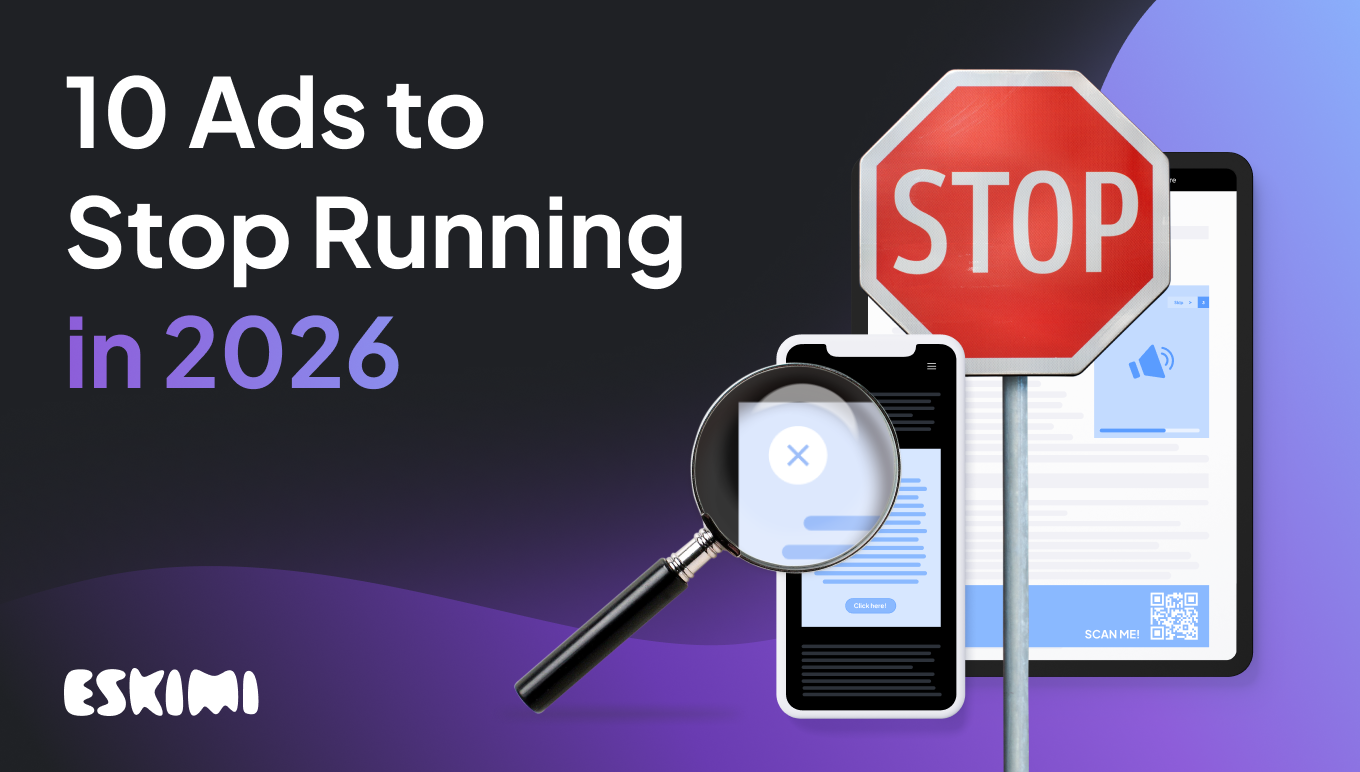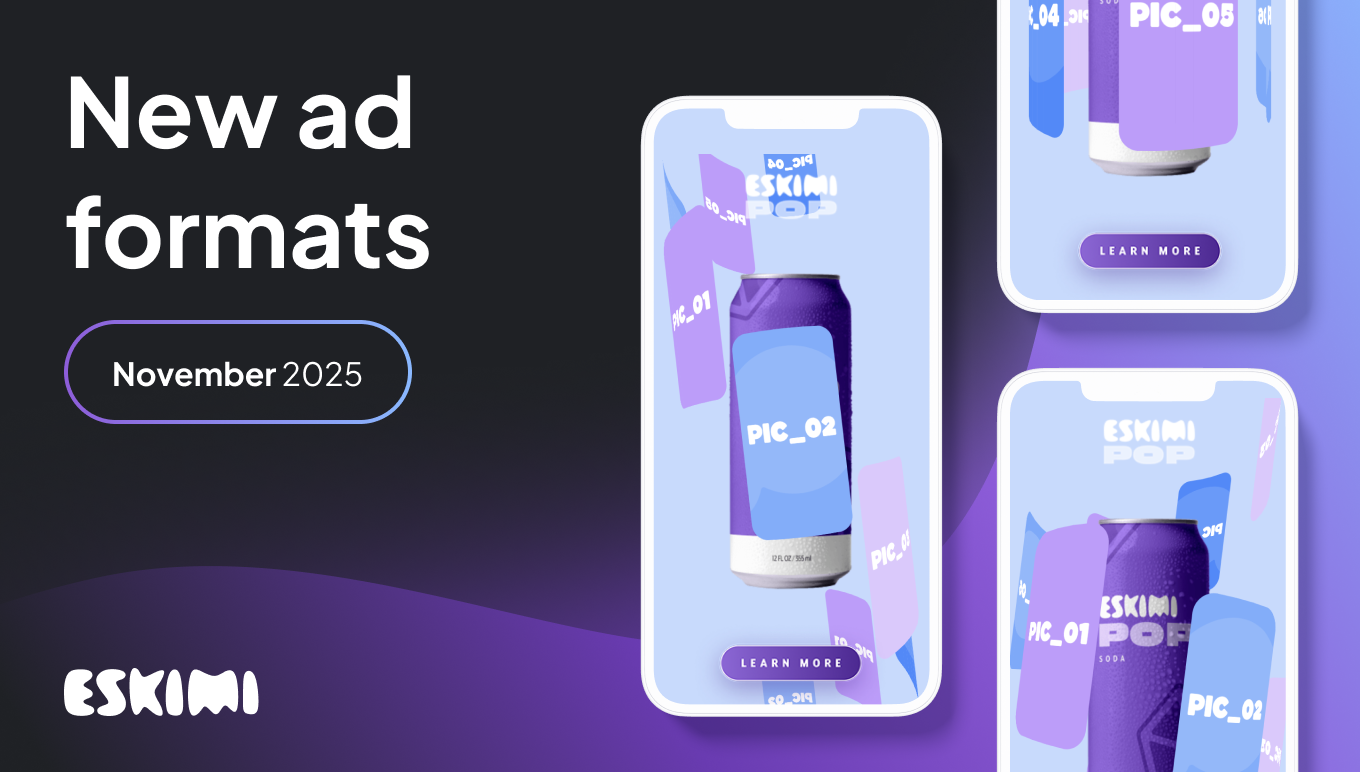Programmatic ad targeting: how to reach your audience

Every brand should know its audience by heart to run ad campaigns effectively and efficiently. This is key for crafting highly relevant ads – delivering the right message to the right person – and increasing the chances they'll find it appealing.
Otherwise, you're wasting your ad money on people who are unlikely to be interested in what you have to offer. Or, as the popular marketing saying goes, "If you're targeting everyone, you're actually targeting no one."
But how do you reach relevant audiences with precision, scale, and without wasting your ad spend? Enter programmatic advertising – an automated, data-driven approach to buying and placing ads that offers advanced targeting capabilities, helping you reach the right target audience, at the right time, in the right context.
Let's dive deeper into programmatic targeting, learn how it works, and explore the targeting tactics you can use to promote your business effectively.
Programmatic advertising definition
Let's begin with programmatic advertising definition. Programmatic advertising is one of the digital advertising types that enables the automated buying and selling of digital ad space using software and algorithms, rather than manual processes.
Unlike traditional ad buying process, which involves human negotiations and manual insertion orders, programmatic replaces this with technology that makes decisions to buy ad space in milliseconds.
How does programmatic advertising work?
To understand how it works, it's helpful to look at the programmatic advertising ecosystem, which includes several key programmatic advertising platforms:
- Advertisers: Brands or agencies that want to promote their products or services via a digital advertising campaign.
- Demand-side platforms (DSPs): Programmatic advertising platforms that allow advertisers to purchase digital ad inventory automatically, targeting specific audiences based on audience data.
- Publishers: Website or app owners offering digital ad inventory.
- Supply-side platforms (SSPs): Used by publishers to manage and sell their available ad space.
- Ad exchanges: Digital marketplaces where DSPs and SSPs meet, where publishers can offer their available ad slots and advertisers can bid and purchase ad inventory.
- Data management platforms (DMPs): These collect and analyze user data, helping advertisers enhance targeting accuracy.

These components work together behind the scenes to automate ad delivery with speed, scale, and precision.
There are a few programmatic ad buying methods, each offering a different level of control and exclusivity:
- Real-Time Bidding (Open Auction or RTB): In real-time bidding, multiple advertisers compete to win ad slots on a publisher's website for the best price. The highest bidder wins the auction, and the ad is displayed.
- Private Marketplace (PMP): A PMP is similar to an Open Auction, but the auction is not truly open. Instead, publishers offer their ad inventory to an invited group of advertisers, who compete to win the ad placement at the best price.
- Programmatic Guaranteed: Programmatic Guaranteed enables advertisers to reserve ad inventory directly from publishers, guaranteeing a fixed number of impressions at a predetermined price. Then, the inventory is designated for a particular buyer, and they are obliged to buy it.
- Preferred Deals: PD is similar to Programmatic Guaranteed – advertisers and publishers agree on a fixed price, and the advertiser has priority to bid at the agreed-upon price. If denied, the publisher can sell this inventory at open or private auctions.
Automation, large datasets, and algorithmic tools are among the key factors that differentiate programmatic media buying from other, more traditional methods. However, this doesn't mean that programmatic doesn't require a human touch – there are still some things that need to be created or added manually (like Insertion Orders), but it still frees up advertisers' schedules, leaving more time for optimizing ad campaigns in real time for the best results.
Main types of data used for programmatic ad targeting
.avif)
hen you browse the internet, you typically leave behind a trail of data about your recent activities that companies collect, store, and later use for advertising purposes.
This can include anything from using a search engine to making a purchase online.
Depending on their advertising goals, brands can either use only one type of data (e.g., behavioral, like pages a user visits, products viewed, or content checked) or a combination of different information to reach their potential customers.
Typically, there are three types of data used for programmatic advertising.
First-party data
First-party data is data that a company collects directly from its own customers or website visitors.
It can include information such as purchase history, website interactions, or demographic data that a customer agrees to provide directly to the company (typically by accepting a cookie storing policy on their website).
First-party data is the most valuable as it's unique to each company and can be used to create more personalized experiences and precisely targeted advertising campaigns.
Second-party data
Second-party data refers to information that one company collects and shares with another for mutual benefit. Or in other words, data that you acquire from your trusted partner.
For example, a company might share its first-party data with another company that has a complementary product or service to reach a broader audience.
Second-party data is also typically of high quality because it originates from a trusted source; however, it may be limited in scope compared to first-party data.
Third-party data
Third-party data is collected by a third-party provider specializing in gathering and aggregating data from multiple sources, such as apps and websites. Examples of these include demand-side platforms (DSPs), data management platforms (DMPs), third-party data marketplaces, and similar entities.
Third-party data can include demographic and behavioral information that can be used for audience targeting and segmentation. Since it's collected from multiple data sources, it's often less accurate than first- and second-party data; however, it can help fill in gaps in a company's own data.
Most common programmatic targeting strategies
Reaching target audiences is one of the key purposes for gathering these insights as it can help to learn who they are, how they behave online, and what they're interested in.
It's often better to narrow down your audience to people who are more likely to interact with your offers and convert, and this can be done based on multiple criteria.
Here are some of the most common programmatic targeting types you should know and use.
Demographic targeting

Demographic targeting is a targeting type that focuses on reaching people based on their specific demographic characteristics, including:
- Age
- Gender
- Income
- Parental status
- Location
- Occupation
- Marital status
- Education
Demographic targeting is based on the idea that groups of people that fall under a specific demographic "definition" might have similar interests and preferences. By targeting these groups, advertisers can improve the relevance and effectiveness of their campaigns.
For instance, a company specializing in coffee-to-go may want to target people between 18-35 who live in urban areas, as they are more likely to be on the move/in a hurry.
Advertisers can use demographic data to create profiles of their target audience and tailor their offers to particular interests and user preferences. This can lead to higher engagement and click-through rates, possibly resulting in higher revenue.
Demographic targeting example: ABC Extra Stout
Stout beers are mostly associated with older generations since they are stronger, dark, and heavy-bodied. ABC Extra Stout, one of the Heineken-owned beer brands, was not an exception.
The brand, which sought to change this perception, underwent a rebranding, positioning ABC Extra Stout as a drink for a new generation of buyers. Therefore, together with Eskimi, it ran an in-game advertising campaign, targeting 18+-year-olds while they are playing mobile games.
Besides hitting campaign's KPIs, ABC Extra Stout managed to reach more than 63% of players between the age of 18 and 34, fulfilling the company's goal.
Behavioral targeting

Behavioral targeting is a type of targeting that involves analyzing users' online activities and using that information to deliver personalized offers. Simply put, it considers what a user does while browsing the internet and allows brands to use this information to craft highly relevant ads.
Typically, it is done by collecting and analyzing such data as:
- User's browsing history
- Search queries
- Purchase history
- Searches within specific sites or pages viewed
- Content checked
- Interaction with site elements, etc.
This way, advertisers can better understand how people they are trying to reach act online and how to use this data to bring them value with the company's offers.
For example, if a user frequently visits websites related to beauty topics, you can use this information to promote your cosmetics brand, beauty salon, or other relevant products or services.
Another example could be identifying when your target audience is the most active online (e.g., stay-at-home moms) and using daypart targeting (a subtype of behavioral targeting) to reach them when the chances they will act are the highest.
Since behavioral targeting focuses on specific user behavior (hence the name), it can help create ads that better resonate with the audience's interests, thereby creating a better user experience.
Contextual targeting

Contextual targeting is often mixed with behavioral targeting, but these two targeting types have one fundamental difference.
While behavioral targeting focuses on the behavior of previous website visitors, contextual targeting considers the content users are currently engaging with online.
In other words, if you're reading an article about where coffee beans come from, you can become a target for coffee-related product/service ads.
In contextual targeting, advertisers use keywords, topics, or categories to identify a website's context and deliver relevant ads accordingly.
One of the most significant benefits of this targeting type is that it can help reach users who have just gotten interested in a particular topic but haven't performed any searches or made purchases; therefore, it's too soon to use behavioral targeting on them.
Geotargeting
.avif)
Geotargeting delivers ads based on the geographic location of potential customers, often using IP addresses to determine that location.
Among the key benefits of location-based ads is the ability to deliver ads tailored to the local market. For instance, a hairdresser might use geotargeting to deliver ads promoting their services to people who are in the nearby area, or a farmer may promote their organic produce to potential buyers in a specific city.
Device targeting

Device, or tech targeting, is a targeting type that allows advertisers to deliver ads to users based on several device-related factors, such as:
- Specific device they're using to access the internet (desktop, mobile, tablet)
- Device brand and model
- Device price range
- Operating system
- Operator
- Browser and other data points
Device targeting can be used to optimize ad delivery based on the device's characteristics, e.g., tailoring ads for mobile devices with smaller screens than desktop devices or identifying users' purchasing power.
If an advertiser wants to deliver high-quality video ads, they can also use this audience targeting type to tailor the programmatic ads to the capabilities of users' devices. Meanwhile, simpler static image ads may perform better on older devices and slower internet speeds.
Retargeting

Retargeting falls under behavioral targeting, but it's an important targeting type that deserves to have its own section.
Retargeting is an advertising technique that enables brands to show their ads to users who have previously shown interest in relevant topics and visited particular sites or apps.
Retargeting works by tracking the behavior of website visitors using cookies or pixels. Then, it allows displaying targeted ads to those users as they browse the internet.
For example, if a user visits a sports website, they may see a sports brand serving them relevant ads.
Retargeting is also one way to increase brand awareness and customer loyalty by keeping your brand top-of-mind for potential customers. Moreover, it helps boost conversions by targeting people who are either interested in specific areas or have already shown interest in your product or services.
Reach your audience where they are
If you want to reach your ideal audience with precision and efficiency, programmatic advertising is the way to go.
From demographic to tech, it comes with a wide variety of targeting types that each have their own advantages and can be customized to fit specific campaign and company goals.
Knowing what's out there and the possibilities programmatic targeting can offer can help you maximize the effectiveness of your campaigns, provide more personalized experiences for your potential customers, and increase your ROI.
Looking to launch a great targeted programmatic campaign? Contact the Eskimi team or book a demo for a smooth start.
Level Up Your Advertising with Eskimi
- Reach 96% of Open Web
- 2,500+ Targeting Options
- 100% Managed or Self-Service
- In-House Creative Studio Team
- Display, Video, In-Game & CTV
- #1 Rated DSP on G2




.png)